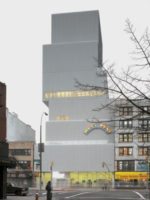Four years ago I wandered the ruins of the Hexagon, a 1920s pavilion for exhibiting tractors in Gorky Park, which was slated to become the new home of the Garage Center for Contemporary Culture. With its temple-like colonnades, it seemed a fittingly grand setting for the art-world ambitions of Dasha Zhukova, wife of billionaire Roman Abramovich. But, shortly afterward, it was listed as a historic monument, and the project moved to another ruin nearby, a derelict cafeteria. This was not quite the demotion it may sound. The 1968 structure was once able to feed 1,200 people in a sitting'Soviet proportions can easily accommodate the 21st-century culture industry.
Rem Koolhaas describes this project as a work of preservation. He invokes OMA/AMO's 2010 exhibition at the Venice Biennale, Cronocaos, in which he argued with characteristically intricate contradiction that the world has gone preservation mad and yet we must preserve the socialist and social-democratic architecture of the postwar years. With Garage, he has been able to save a piece of that legacy, though this is not preservation in the standard, precious mode.
In the central atrium the remains of the restaurant are plainly displayed'the old brick walls, patchily covered with lovely green ceramic tiles, and a Socialist Realist mosaic depicting autumn. The two brick cores'one of which used to house a vast kitchen and the other the staircase'now contain an auditorium, education spaces, and a small caf'. The exhibition spaces wrap around these cores on two levels, accessed by restored terrazzo staircases with new black-steel railings. What has been preserved here is the texture of the interior and the public-minded generosity of space.
The shell, however, is uncompromisingly new. The relatively cheap polycarbonate skin was chosen because this was supposed to be a temporary home for Garage in advance of the move to the tractor temple, but it became permanent. Koolhaas has presented the modesty of materials and form as the antidote to so much 'spectacular' architecture, but it is also practical. One meter deep, the translucent double skin contains the services that provide the necessary climatic conditions for showing art. And thus'much to the bemusement of the Russian contractors'the wires, pipes, and such remain visible through the facade. The architects describe this skin as the 'machine' that enables a ruin to work as a museum.
And that is what this now is. Garage has become the Garage Museum of Contemporary Art'a shift from private gallery to the status of a public institution. Consequently, the program also has a new orientation toward research and education, with archival exhibitions exploring Soviet-era art and international cultural relations.
Whether this is a good space for showing art is not yet proven. Apart from the open central spaces'in one of which artist Rirkrit Tiravanija has installed Ping-Pong tables and old ladies serving dumplings'the galleries are slightly cramped. There is much less exhibition space here than in the 1926 Konstantin Melnikov'designed bus garage where Garage began (and got its name). And the curators are a little anxious about the lack of white-cube spaces. Hinged display panels can be raised up to the ceiling to offer a choice of white-wall or exposed-brick hanging surfaces, a nice idea that may not stand the test of time.
Still, the building feels good. The glazed ground floor is entirely open to the greenery of the surrounding park, and the expansive sense of space is inviting. Perhaps not quite a contradiction, it is certainly curious to see a relic of Soviet public-spiritedness transformed into a symbol of oligarchic patronage. But in the new Russia, it seems, it falls to billionaires to create the public institutions of contemporary culture.
PeopleClient: Iris Foundation/Park Development Architect: OMA — Rem Koolhaas
Personnel who should receive special credit: Project architect: Ekaterina Golovatyuk Team: Giacomo Cantoni, Nathan Friedman, Cristian Mare, John Paul Pacelli, Cecilia del Pozo, Timur Shabaev, Chris van Duijn, Yashin Kemal, Timur Karimullin, Federico Pompignoli, Marek Chytil, Salome Nikuradze, Boris Tikvarski Local Architects: Form Bureau (concept phase); Buromoscow (construction phase)
Engineers:
Consultants: Photographer: Iwan Baan Size: 58,100 square feet Cost: withheld Completion Date: June 2015 |
Products
Structural system
Exterior cladding Wood: façade Lumi (RU)
Other cladding unique to this project:
Windows Interior finishess unique to this project: birch plywood (Nayada, RU), Anodized aluminum (Nayada, RU), tinted oak Parquet (Nayada, RU), Resin Floor (Pol-Beton, RU)
Furnishings |

































